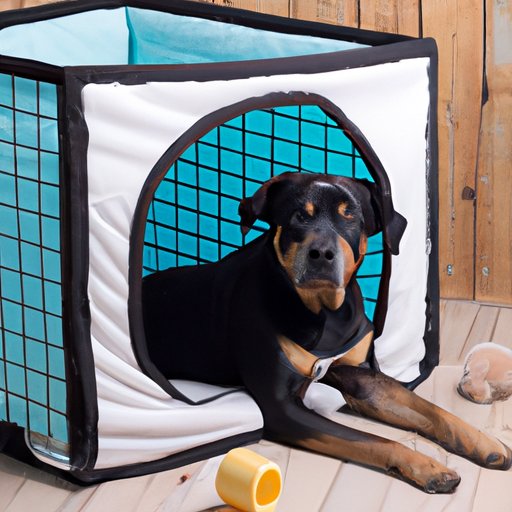
Introduction
Crating training is often associated with puppies, but it can be beneficial for dogs of all ages. However, older dogs may be resistant to this new confinement. Crate training an older dog can be a difficult task, but it is not impossible. In this article, we will discuss the benefits of crate training older dogs, the challenges that may arise, and provide a step-by-step guide to successfully crate train your older dog.
Why it’s Never too Late to Crate Train Your Dog
Crate training can be beneficial for older dogs in many ways. It can improve their behavior, keep them safe when unsupervised, and provide them with a comfortable space of their own. To begin crate training, introduce your dog to the crate gradually, making it a positive experience. Start by placing treats, toys, and blankets inside the crate, and allowing your dog to explore it on their own. Slowly increase the amount of time your dog spends in the crate. Eventually, your dog will become comfortable with the crate and see it as a safe and comforting space of their own.
The Challenges of Crate Training an Older Dog and How to Overcome Them
Older dogs may have a harder time adjusting to crate training due to their established routines and possible negative associations with confinement. Common challenges may include barking, whining, and feeling anxious or scared in the crate. It is important to address these challenges by providing plenty of exercise, attention, and positive reinforcement. Gradually increase the time spent in the crate and make sure the crate is comfortable with plenty of toys and bedding. Patience and consistency are key in overcoming these challenges.
How to Make Crate Training a Positive Experience for Your Older Dog
Making the crate a positive experience for your older dog involves creating a comfortable and inviting space. Place the crate in a quiet part of the house, away from high traffic areas. Provide plenty of comfortable bedding and toys. Avoid negative associations with the crate, such as using it for punishment or leaving your dog in it for extended periods. Use positive reinforcement, such as treats and praise, when your dog enters the crate and gradually increase the amount of time spent in the crate.
Avoiding Common Mistakes When Crate Training an Older Dog
Common mistakes when crate training an older dog include forcing the dog into the crate, using the crate for punishment, and leaving the dog in the crate for too long. These mistakes can create negative associations with the crate and make crate training more difficult. To avoid these mistakes, make sure to introduce the crate gradually and use positive reinforcement to encourage your dog to enter the crate on their own.
Crate Training an Older Rescue Dog: What You Need to Know
Rescue dogs may have a harder time adjusting to crate training due to their unknown backgrounds. They may have negative associations with confinement or have never been introduced to a crate before. It is important to introduce the crate gradually and use positive reinforcement to create a positive association with the crate. Take into consideration your dog’s background and make sure to give them plenty of exercise and attention before introducing them to the crate. Patience and consistency are key in crate training an older rescue dog.
How Long Does it Take to Crate Train an Older Dog?
The timeline for crate training an older dog varies depending on the individual dog. Some dogs may adjust to the crate quickly, while others may take more time. The key is to be patient and consistent, gradually increasing the amount of time spent in the crate. Avoid rushing the process and make sure to use positive reinforcement throughout crate training.
Conclusion
Crate training an older dog can be challenging, but it is not impossible. By introducing the crate gradually, providing comfort, and using positive reinforcement, you can successfully crate train your older dog. It is important to be patient and consistent, and to avoid common mistakes. With these tips and strategies, crate training an older dog can be a positive experience for both you and your furry companion.




